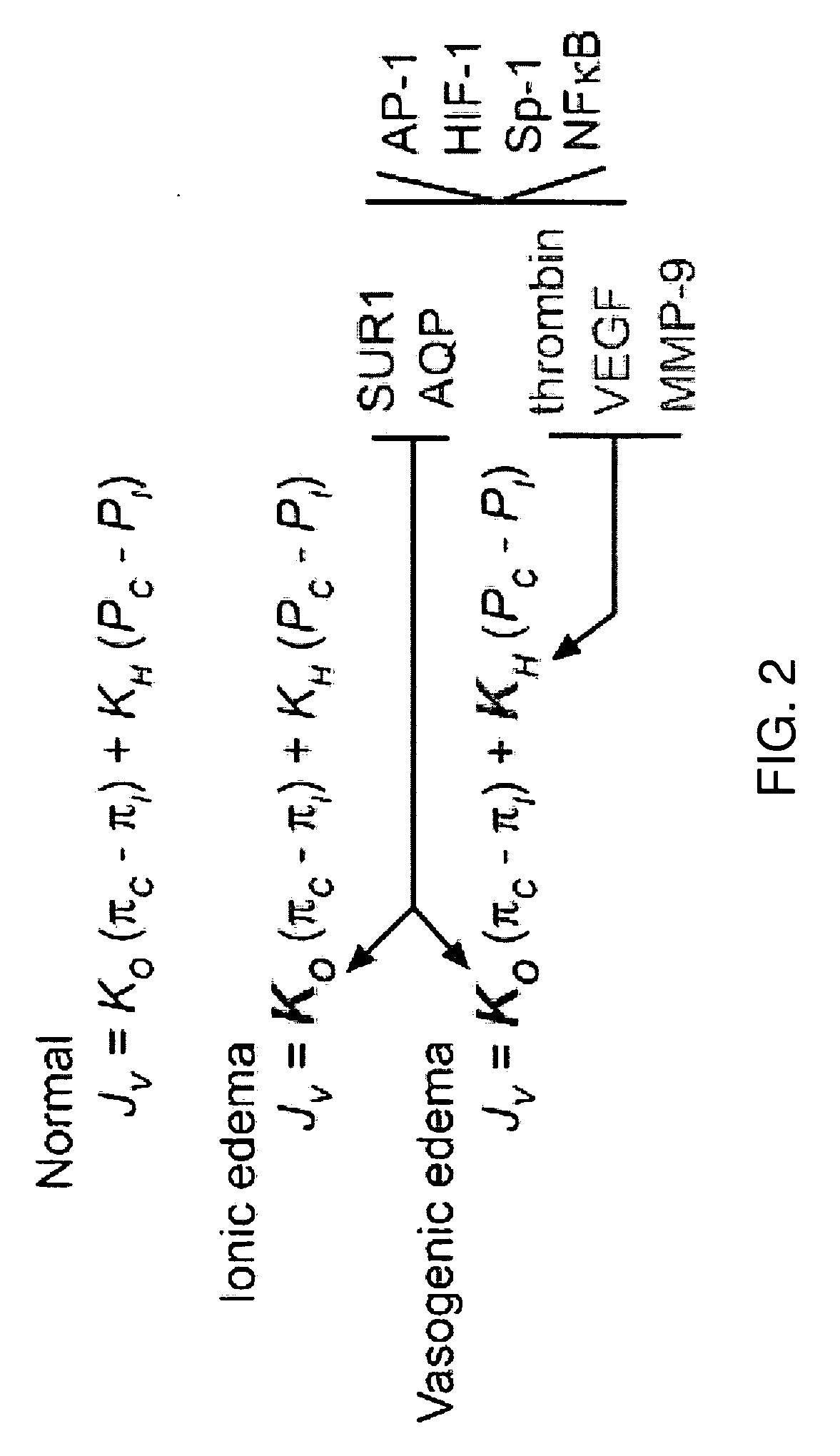Antagonists of a non-selective cation channel in neural cells
a non-selective, neural cell technology, applied in the field of cell biology, molecular biology, neurophysiology, medicine, can solve the problems of serious consequences of nerve injury, morbidity and mortality, worsening outcome, etc., to reduce stroke size, reduce mortality of subjects, and reduce edema
- Summary
- Abstract
- Description
- Claims
- Application Information
AI Technical Summary
Benefits of technology
Problems solved by technology
Method used
Image
Examples
example 1
TRPM4—The Pore-Forming Subunit of the NCCa-ATP Channel
[0400]The SUR1-regulated NCCa-ATP channel is a novel cation channel. Its importance lies in the fact that it is critically involved in cell death in CNS tissues, including brain and spinal cord. The SUR1-regulated NCCa-ATP channel is not normally expressed in the CNS, but is expressed only following hypoxia, injury or inflammation.
[0401]The channel has been extensively studied in rodent models of disease. It was first discovered in reactive astrocytes obtained from the gliotic capsule surrounding a foreign body implanted into the rat brain (Chen et al., 2001; Chen et al., 2003). Since then, it has also been identified in neurons from the core of an ischemic stroke (Simard et al., 2006) and in spinal cord neurons and capillaries following traumatic injury (Simard et al., 2007) and in cultures of murine CNS capillary endothelial (bEnd.3) cells subjected to hypoxia. Evidence of the channel, as indicated by SUR1 expression, is also ...
example 2
TRPM4 and the SUR1-Regulated NCCa-ATP Channel
[0407]The SUR1-regulated NCCa-ATP channel is composed of pore-forming plus regulatory subunits. The pore-forming subunits were not previously identified at the molecular level, but it was noted that many of the biophysical properties of the SUR1-regulated NCCa-ATP channel are similar to those of TRPM4 (see Table 2). TRPM4, together with TRPM5, are the only molecular candidates presently known for the class of non-selective, Ca2+-impermeable cation channels that are activated by intracellular Ca2+ and blocked by intracellular ATP, i.e., NCCa-ATP channels.
[0408]Both the SUR1-regulated NCCa-ATP channel and TRPM4 are highly selective for monovalent cations, have no significant permeation of Ca2+, are activated by internal Ca2+ and blocked by internal ATP. The two channels have several features in common (Table 2).
[0409]The high sensitivity to glibenclamide exhibited by the SUR1-regulated NCCa-ATP channel requires expression of SUR1. In certa...
example 3
TRPM4 Channel in Spinal Cord Injury
Spinal Cord Injury—the Clinical Problem
[0438]Acute spinal cord injury (SCI) results in physical disruption of spinal cord neurons and axons leading to deficits in motor, sensory, and autonomic function. The concept of secondary injury in SCI arises from the observation that the volume of injured tissue increases with time after injury, i.e., the lesion itself expands and evolves over time (Tator and Fehlings, 1991; Kwon et al., 2004). Whereas primary injured tissues are irrevocably damaged from the very beginning, right after impact, tissues that are destined to become “secondarily” injured are considered to be potentially salvageable. Older observations based on histological studies that gave rise to the concept of lesion-evolution have been confirmed with non-invasive MRI (Bilgen et al., 2000; Weirich et al., 1990; Ohta et al., 1999; Sasaki et al., 1978).
[0439]Numerous mechanisms of secondary injury are recognized, including edema, ischemia, oxi...
PUM
| Property | Measurement | Unit |
|---|---|---|
| single-channel conductance | aaaaa | aaaaa |
| single-channel conductance | aaaaa | aaaaa |
| concentration | aaaaa | aaaaa |
Abstract
Description
Claims
Application Information
 Login to View More
Login to View More - R&D
- Intellectual Property
- Life Sciences
- Materials
- Tech Scout
- Unparalleled Data Quality
- Higher Quality Content
- 60% Fewer Hallucinations
Browse by: Latest US Patents, China's latest patents, Technical Efficacy Thesaurus, Application Domain, Technology Topic, Popular Technical Reports.
© 2025 PatSnap. All rights reserved.Legal|Privacy policy|Modern Slavery Act Transparency Statement|Sitemap|About US| Contact US: help@patsnap.com



